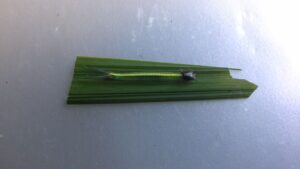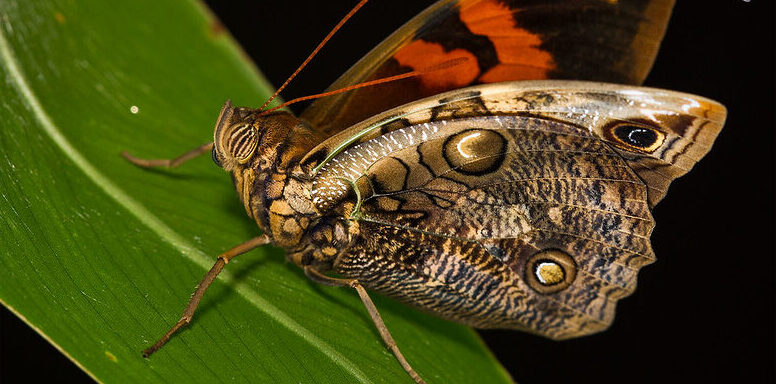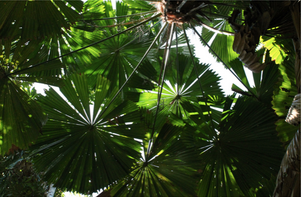Opsiphanes cassina is a species of butterfly of the family Nymphalidae. It belongs to the order Lepidoptera. It is found in Mexico and all the way down to the Amazon basin. Multiple subspecies can be found from Mexico to Panama. The adult Opsiphanes is a light brown butterfly with a wingspan of about 72mm with lighter yellow spots that form the shape of a “Y” in its posterior wings with an activity period of 7 to 10 days. Their larvae can measure up to 90mm long, and they are green with yellow stripes on the sides. They have a crown at their head with multiple horn-type of filaments that give its popular similitude to a dragon. Their tail has an elongated “V” shape that can be easily spotted. Their life cycle lasts around 70 days, shortening considerably during dry periods.
The larvae of Opsiphanes cassina only feed on monocotyledonous plants, a very specific group of flowering plants with seeds that possess only one cotyledon in their embryos. Acrocomia vinifiera, Cocos nucifera y Bactris are among their host plants. In fact, the larvae are considered a plague for crops of the palm Elaeis guineensis, a monocot commonly known as oil palm. It is a very popular plant for its production accounts for a very large percentage of the global oils produced from oil crops. The Opsiphanes cassina causes severe defoliation in these palms. Their larvae usually pupate inside the palm leaves. One single larva can devour up to three leaflets during their growth period until they become pupas.

The control methods for this plague can be extremely problematic to the natural enemies and their potential capacity of reducing the population of the plague. In 2007 a study was made to make a list of the biological regulators that naturally affect the population in oil palm crops. The study collected a list of eight species of parasitoid and one predator: Brachymeria, Cotesia, Sarcodexia innata, Conura, Tetrastichus, Telenomus, Rhysipolis, Aleiodes, y Alcaeorrhynchus grandis. The genus Beauveria has also been reported as an entomopathogenic fungus to the defoliator insects of the oil palm (Escalante, 2007).
This information can be extremely useful for the palm growers that have to deal with the presence of Opsiphanes cassina in their crops. Many have started to farm populations of the species that act as population controllers of the Opsiphanes cassina to release them in their plantations and promote a more natural process of depuration in comparison to the application of insecticide which can affect the lives of other species in their habitat.
References:
Escalante, M., & Rosales, L. (2007). Insectos y hongos que afectan a Opsiphanes cassina en palma aceitera del sur del Lago de Maracaibo, estado Zulia, Venezuela. Revista Palmas, 28(especial, ), 339-344. Recuperado a partir de https://publicaciones.fedepalma.org/index.php/palmas/article/view/1269




